
Nymphaeaceae is a family of flowering plants, commonly called water lilies. They live as rhizomatous aquatic herbs in temperate and tropical climates around the world. The family contains five genera with about 70 known species. Water lilies are rooted in soil in bodies of water, with leaves and flowers floating on or rising from the surface. Leaves are oval and heart-shaped in Barclaya. Leaves are round, with a radial notch in Nymphaea and Nuphar, but fully circular in Victoria and Euryale.

Victoria or giant waterlily is a genus of aquatic herbs in the plant family Nymphaeaceae. Its leaves have a remarkable size: Victoria boliviana produces leaves up to 3.2 metres (10 ft) in width. The genus name was given in honour of Queen Victoria of the United Kingdom.
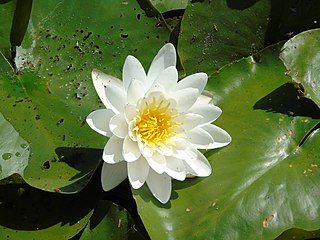
Nymphaea is a genus of hardy and tender aquatic plants in the family Nymphaeaceae. The genus has a cosmopolitan distribution. Many species are cultivated as ornamental plants, and many cultivars have been bred. Some taxa occur as introduced species where they are not native, and some are weeds. Plants of the genus are known commonly as water lilies, or waterlilies in the United Kingdom. The genus name is from the Greek νυμφαία, nymphaia and the Latin nymphaea, which means "water lily" and were inspired by the nymphs of Greek and Latin mythology.

Nuphar is a genus of aquatic plants in the family Nymphaeaceae, with a temperate to subarctic Northern Hemisphere distribution. Common names include water-lily, pond-lily, alligator-bonnet or bonnet lily, and spatterdock.

Nuphar lutea, the yellow water-lily, brandy-bottle, or spadderdock, is an aquatic plant of the family Nymphaeaceae, native to northern temperate and some subtropical regions of Europe, northwest Africa, and western Asia. This species was used as a food source and in medicinal practices from prehistoric times with potential research and medical applications going forward.

Nymphaea mexicana is a species of aquatic plant that is native to the Southern United States and Mexico as far south as Michoacán. Common names include yellow water lily, Mexican water lily and banana water lily.
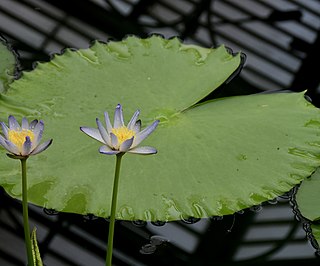
Nymphaea macrosperma is an annual or perennial, aquatic, rhizomatous herb in the family Nymphaeaceae native to Australia and New Guinea.

Nymphaea leibergii, also known as the dwarf waterlily and Leiberg's waterlily, is a perennial emergent aquatic plant belonging to the genus Nymphaea. It can be found across northern North America in ponds and slow moving streams. Populations of this plant are infrequent throughout its range, and it is protected as a state threatened plant in Maine, Michigan, and Minnesota.

Nymphaea nouchali, often known by its synonym Nymphaea stellata, or by common names blue lotus, star lotus, red water lily, dwarf aquarium lily, blue water lily, blue star water lily or manel flower, is a water lily of genus Nymphaea. It is native to southern and eastern parts of Asia, and is the national flower of Bangladesh and Sri Lanka. In Sanskrit it is called utpala. This species is usually considered to include the blue Egyptian lotus N. nouchali var. caerulea. In the past, taxonomic confusion has occurred, with the name Nymphaea nouchali incorrectly applied to Nymphaea pubescens.

Euryale is a genus of flowering plants of the family Nymphaeaceae.

The Paradisus Londonensis is a book dated 1805–1808, printed by D.N. Shury, and published by William Hooker. It consists of coloured illustrations of 117 plants drawn by William Hooker, with explanatory text by Richard Anthony Salisbury.

Nymphaea tetragona is an aquatic perennial, species of flowering plant commonly called pygmy waterlily and small white water lily, belonging to the family Nymphaeaceae.
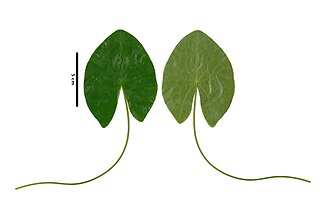
Nymphaea glandulifera is a species of waterlily native to tropical America.
Nymphaea tenuinervia is a species of waterlily native to Colombia, Guyana and Brazil.

Nymphaea × daubenyana is a species of waterlily endemic to Chad, but has been introduced to Florida, USA. It is a natural hybrid of Nymphaea micrantha and Nymphaea nouchali var. caerulea.
Nymphaea nouchali var. versicolor is a variety of the water lily species Nymphaea nouchali Burm.f. naturally found in tropical Asia.
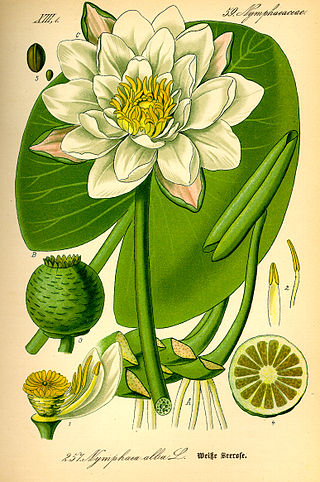
Nymphaea subg. Nymphaea is a subgenus of the genus Nymphaea.

Trithuria bibracteata is a species of aquatic plant in the family Hydatellaceae endemic to Western Australia.

Nymphaea sect. Chamaenymphaea is a section within the subgenus Nymphaea subg. Nymphaea of the genus Nymphaea native to North America, Asia, and Europe.
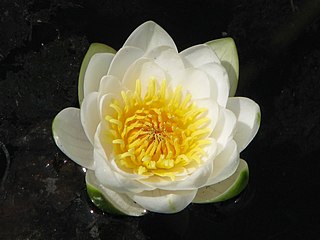
Nymphaea sect. Nymphaea is a section within the subgenus Nymphaea subg. Nymphaea of the genus Nymphaea native to North America and Europe.


















